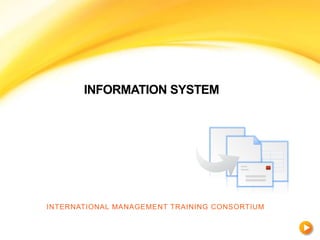
INFORMATION SYSTEM.pptx
- 1. INFORMATION SYSTEM INTERNATIONAL MANAGEMENT TRAINING CONSORTIUM
- 2. 2 INFORMATION SYSTEMS Why Do People Need Information? • Individuals - Entertainment and enlightenment • Businesses - Decision making, problem solving and control
- 3. 3 DATA, INFORMATION, AND SYSTEMS Data vs. Information • Data • A “given,” or fact; a number, a statement, or a picture • Represents something in the real world • The raw materials in the production of information • Information • Data that have meaning within a context • Data in relationships • Data after manipulation
- 4. 4 DATA, INFORMATION, AND SYSTEMS Data Manipulation • Example: customer survey • Reading through data collected from a customer survey with questions in various categories would be time- consuming and not very helpful. • When manipulated, the surveys may provide useful information.
- 5. 5 DATA, INFORMATION, AND SYSTEMS Generating Information • Computer-based ISs take data as raw material, process it, and produce information as output. Figure 1.1 Input-process-output
- 6. 6 DATA, INFORMATION, AND SYSTEMS Information in Context
- 7. 7 DATA, INFORMATION, AND SYSTEMS What Is a System? • System: A set of components that work together to achieve a common goal • Subsystem: One part of a system where the products of more than one system are combined to reach an ultimate goal • Closed system: Stand-alone system that has no contact with other systems • Open system: System that interfaces with other systems
- 8. 8 DATA, INFORMATION,AND SYSTEMS Figure 1.3 Several subsystems make up this corporate accounting system.
- 9. Computer Hardware Computer Software Telecommunications and Computer Networks Data Resource Management
- 10. Operational Support Systems •Transaction Processing System •Process Control System Management Support Systems •Management Information System (MIS) •Decision Support System (DSS) •Executive Support System (ESS)
- 11. The tangible elements of a computer system The components that store and process data, perform calculations Input devices like the keyboard and mouse allow users to enter data and commands. Storage and processing components consist of the hard drive and other storage components like flash drives.
- 12. Desktop (Personal) Computers Server Mainframes Supercomputers Notebook Computers Handheld Devices
- 13. Programs, routines, and computer languages that control a computer Operating System • Windows Operating System • Mac Operating System Application Software • Microsoft PowerPoint • Quicken
- 14. THE INTERNET Local Area Networks (LAN) Wide Area Networks (WAN) Wireless Local Networks Intranets Virtual Private Networks (VPN) Voice over Internet Protocol (VoIP)
- 15. E-Crime Computer Viruses • Worms • Trojan Horses • Spyware
- 16. Natural Disasters Power Failures Equipment Malfunctions Software Glitches Human Error Terrorist Attacks The most basic precaution – Backup. 90% of firms that sustained a loss of critical data went out of business within two years.
- 17. The Distributed Workforce • Employees who work in virtual offices Application Service Providers • A firm that provides computers and application support On Demand, Cloud, and Grid Computing • Renting software time
- 18. 18 DATA, INFORMATION,AND SYSTEMS Information and Managers • Systems thinking • Creates a framework for problem solving and decision making. • Keeps managers focused on overall goals and operations of business.
- 20. 20 DATA, INFORMATION, AND SYSTEMS The Benefits of Human-Computer Synergy • Synergy • When combined resources produce output that exceeds the sum of the outputs of the same resources employed separately • Allows human thought to be translated into efficient processing of large amounts of data
- 21. 21 DATA, INFORMATION, AND SYSTEMS
- 22. 22 DATA, INFORMATION, AND SYSTEMS The Four Stages of Data Processing • Input: Data is collected and entered into computer. • Data processing: Data is manipulated into information using mathematical, statistical, and other tools. • Output: Information is displayed or presented. • Storage: Data and information are maintained for later use.
- 23. 23 WHY STUDY IS? Information Systems Careers • Systems analyst, specialist in enterprise resource planning (ERP), database administrator, telecommunications specialist, consulting, etc. Knowledge Workers • Managers and non-managers • Employers seek computer-literate professionals who know how to use information technology. Computer Literacy Replacing Traditional Literacy • Key to full participation in western society
- 24. 24 ETHICALAND SOCIETAL ISSUES THE NOT-SO-BRIGHT SIDE Consumer Privacy • Organizations collect (and sometimes sell) huge amounts of data on individuals. Employee Privacy • IT supports remote monitoring of employees, violating privacy and creating stress.
- 25. 25 ETHICALAND SOCIETAL ISSUES THE NOT-SO-BRIGHT SIDE Freedom of Speech • IT increases opportunities for pornography, hate speech, intellectual property crime, an d other intrusions; prevention may abridge free speech. IT Professionalism • No mandatory or enforced code of ethics for IT professionals--unlike other professions. Social Inequality • Less than 20% of the world’s population have ever used a PC; less than 3% have Internet access.
